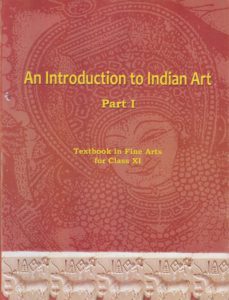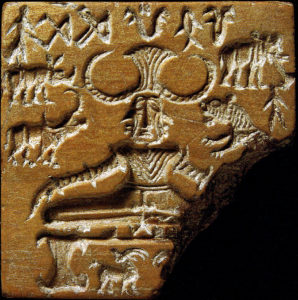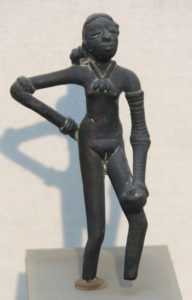This post covers the brief summary of Chapters 1 to 4 of AN INTRODUCTION TO INDIAN ART Textbook in Fine Arts for Class XI for the upcoming IAS Prelims Exam.
Chapter 1 – PREHISTORIC ROCK PAINTINGS
- The first discovery of rock paintings was made in India in 1867–68 by an archaeologist, Archibold Carlleyle.
- The caves of Bhimbetka were discovered in 1957–58 by eminent archaeologist V.S. Wakankar.
- The largest number of Prehistoric paintings belong to Period II that covers the Mesolithic paintings. Hunting scenes predominate in Mesolithic paintings.
Chapter 2 – ARTS OF THE INDUS VALLEY
Important Harappa Sites
| IVC SITE | Location |
| Harappa | Pakistan |
| Mohenjodaro | Pakistan |
| Lothal | Gujarat |
| Dholavira | Gujarat |
| Rakhigarhi | Haryana |
| Ropar | Punjab |
| Kalibangan | Rajasthan |
| Balathal | Rajasthan |
- The art of bronze-casting was practiced on a wide scale by the Harappans. Their bronze statues were made using the ‘lost wax’ technique. Eg. Dancing Girl.
- Bronze casting was popular at all the major centers of the Indus Valley Civilisation.
- The Indus Valley people made terracotta images also but compared to the stone and bronze statues the terracotta representations of the human form are crude in the Indus Valley. Eg. Mother goddess, figurines of bearded males with coiled hair.
Seals
- Material used- steatite, agate, chert, copper, faience, and terracotta
- Figures- animals, such as unicorn bull, rhinoceros, tiger, elephant, bison, goat, buffalo, etc.
- The purpose of producing seals was mainly commercial. The seals were also used as amulets, carried on the persons of their owners, perhaps as modern-day identity cards.
- Every seal is engraved in a pictographic script which is yet to be deciphered.
- The most remarkable seal is Pashupati Seal. This seal depicts a human figure seated cross-legged. An elephant and a tiger are depicted to the right side of the seated figure, while on the left a rhinoceros and a buffalo are seen. In addition to these animals two antelopes are shown below the seat.
Pottery
- The Indus Valley pottery consists chiefly of very fine wheel-made wares, very few being hand-made.
- Plain pottery is more common than painted ware.
- Plain pottery is generally of red clay, with or without a fine red or grey slip.
- The black painted ware has a fine coating of red slip.
- Polychrome pottery is rare and mainly comprises small vases decorated with geometric patterns in red, black, and green, rarely white and yellow.
Beads and Ornaments
- a cemetery has been found at Farmana in Haryana where dead bodies were buried with ornaments.
- The bead industry seems to have been well developed. Eg. at Chanhudaro and Lothal.
- From archaeological finds it appears that the people of the Indus Valley were conscious of fashion.
DANCING GIRL
- four-inch-high copper figure
- Found in Mohenjodaro
MALE TORSO
- In this red sandstone figure, there are socket holes in the neck
and shoulders for the attachment of head and arms.
PAINTED EARTHEN JAR
- Found in Mohenjodaro, this jar is made on a potter’s wheel with clay.
MOTHER GODDESS
- The mother goddess figures are usually crude standing female
figures adorned with necklaces hanging over prominent breasts
and wearing a loincloth and a girdle.
Chapter 3 – ARTS OF THE MAURYAN PERIOD
- Buddhism and Jainism were part of the shraman tradition. Both religions became popular as they opposed the varna and jati systems of the Hindu religion.
- Worship of Yakshas and mother goddesses were prevalent during that time. So, multiple forms of worship existed. Yaksha worship was very popular before and after the advent of Buddhism and it was assimilated in Buddhism and Jainism.
Pillars
- The Mauryan pillars are rock-cut pillars thus displaying the carver’s skills, whereas the Achamenian pillars are constructed in pieces by a mason.
- The top portion of the pillar was carved with capital figures like the bull, the lion, the elephant, etc.
- Some of the existing pillars with capital figures were found at Basarah-Bakhira, LauriyaNandangarh, Rampurva, Sankisa, and Sarnath.
- The Mauryan pillar capital found at Sarnath popularly known as the Lion Capital is the finest example of Mauryan sculptural tradition. It is also our national emblem. This pillar capital symbolises Dhammachakrapravartana (the first sermon by the Buddha).
Lomus Rishi cave
- The rock-cut cave carved at Barabar hills near Gaya in Bihar is known as the Lomus Rishi cave.
- The cave was patronised by Ashoka for the Ajivika sect.
Stupa, vihara, and chaitya
- Stupa, vihara, and chaitya are part of Buddhist and Jaina
monastic complexes but the largest number belongs to the
Buddhist religion. Examples- Bairat in Rajasthan and Great Stupa at Sanchi.
Yakshas and Yakhinis
- These monumental images are mostly in the standing position.
- One of the distinguishing elements in all these images is their polished surface.
- One of the finest examples is a Yakshi figure from Didarganj, Patna. It is tall and well-built. It shows sensitivity towards depicting the human physique. The image has a polished surface.
Lion Capital, at Sarnath, near Varanasi
This is one of the finest examples of sculpture from the Mauryan period. Built-in commemoration of the historical event of the first sermon or the Dhammachakrapravartana by the Buddha at Sarnath, the capital was built by Ashoka.
The capital originally consisted of five component parts:
(i) the shaft (which is broken in many parts now),
(ii) a lotus bell base,
(iii) a drum on the bell base with four animals proceeding clockwise,
(iv) the figures of four majestic addorsed lions, and
(v) the crowning element, Dharamchakra, a large wheel
The capital without the crowning wheel and the lotus base has been adopted as the National Emblem of Independent India.
The capital has four lions firmly seated back to back on a circular abacus. The abacus has the depiction of a chakra (wheel) having twenty-four spokes in all the four directions and a bull, a horse, an elephant, and a lion between every chakra is finely carved.
The motif of the chakra becomes significant as a representation of the Dhammachkra in the entire Buddhist art.
DIDARGUNJ YAKSHINI
A Yakshini holding a chauri (flywhisk) from Didargunj near modern Patna is another good example of the sculptural tradition of the Mauryan Period.
Stupa
- The stupa consists of a cylindrical drum and a circular anda with a harmika and chhatra on the top which remains consistent throughout with minor variations and changes in shape and size.
- During the early phase of Buddhism, Buddha is depicted symbolically through footprints, stupas, lotus throne, chakra, etc.
- Gradually narrative became a part of the Buddhist tradition. Thus events from the life of the Buddha, the Jataka stories, were depicted on the railings and torans of the stupas.
- While events from the life of the Buddha became an important theme in all the Buddhist monuments, the Jataka stories also became equally important for sculptural decorations.
The main events associated with the Buddha’s life which were frequently depicted were events related to the birth, renunciation, enlightenment, dhammachakrapravartana, and mahaparinibbana (death).
Among the Jataka stories that are frequently depicted are Chhadanta Jataka, Vidurpundita Jataka, Ruru Jataka, Sibi Jataka, Vessantara Jataka and Shama Jataka.
Chapter 4 – POST-MAURYAN TRENDS IN INDIAN ART AND ARCHITECTURE
Sites where finest sculptures of this period are found-
- Madhya Pradesh- Vidisha, Bharhut
- Bihar- Bodhgaya
- Andhra Pradesh – Jaggayyapeta
- Uttar Pradesh- Mathura
- Odisha- Khandagiri-Udaigiri
- Maharashtra- Bhaja near Pune and Pavani near Nagpur.
Bharhut
- Bharhut sculptures are tall.
- The illusion of three-dimensionality is shown with a tilted perspective.
- The clarity in the narrative is enhanced by selecting main events.
- Narrative panels are shown with fewer characters
- At times more than one event at one geographical place is clubbed in the picture space or only a single main event is depicted in the pictorial space.
- The availability of the space is utilized to the maximum by the sculptors.
- Narrative reliefs at Bharhut show how artisans used the pictorial language very effectively to communicate stories.
Sanchi
- Stupa-1 at Sanchi has upper as well as lower pradakshinapatha or circumambulatory path.
- It has four beautifully decorated toranas depicting various events from the life of the Buddha and the Jatakas.
- Depiction of posture gets naturalistic and there is no stiffness in the body.
- Symbols continue to be used representing the Buddha and the Manushi Buddhas or the past Buddhas.
- According to the textual tradition, there are twenty-four Buddhas but only the first one, Dipankar, and the last six are pictorially represented.
- The historical narratives such as the siege of Kushinara, Buddha’s visit to Kapilavastu, visit of Ashoka to the Ramgrama Stupa are carved with considerable details.
Gandhara, Mathura & Amravati Schools
| Gandhara School | Mathura School | Amravati School |
| Outside influence- Greek (Hellenistic ). So it is also called as Indo greek art | Indigenous (no outside influence) | Indigenous (no outside influence) |
| Material used- Grey Sandstone or blue green sandstone | Spotted red sandstone | white marbles |
| Mainly Buddhist influence | All three religions had influence- Hinduism, Jainism, Buddhism | Mainly Buddhist influence |
| Promoted by Kushana dynasty | Promoted by Kushana dynasty | Satvahana & Ikshvakus |
Early Temples
The shrines of the temples were of three kinds—
(i) sandhara type (without pradikshinapatha),
(ii) nirandhara type (with pradakshinapatha), and
(iii) sarvatobhadra (which can be accessed from all sides).
Important temple sites of this period are
- Deogarh in Uttar Pradesh,
- Eran, Nachna-Kuthara, and Udaygiri near Vidisha in Madhya Pradesh.
Buddhist Monuments of South India
- Vengi in Andhra Pradesh has many stupa sites like Jagayyapetta, Amaravati, Bhattiprolu, Nagarjunkonda, Goli, etc.
- Sculptural form in this area is characterized by intense emotions. Figures are slender, have a lot of movement, bodies are shown with three bents (i.e. tribhanga).
- Guntapalle is a rock-cut cave site near Eluru. Small apsidal and circular chaitya halls have been excavated belonging to the second century BCE.
- The other important site where rock-cut stupas have been excavated is Anakapalle near Vishakhapatnam.
- In Karnataka, Sannati is the largest stupa site excavated so far.
Cave Tradition in Western India
- In Karla, the biggest rock-cut chaitya hall was excavated.
Mainly three architectural types were executed
(i) apsidal vault roof chaitya halls (found at Ajanta, Pitalkhora, Bhaja);
(ii) apsidal vault-roof pillarless hall (found at Thana-Nadsur); and
(iii) flat-roofed quadrangular hall with a circular chamber at the back (found at Kondivite).
Nashik & Junnar Caves
- The vihara caves at Nashik were excavated with front pillars carved with ghata-base and ghata-capital with human figures.
- One such vihara cave was also excavated at Junnar which is popularly known as Ganeshleni because an image of Ganesha belonging to a later period was installed in it.
Ajanta Caves
- It is located in Aurangabad District of Maharashtra State. Ajanta has twenty-nine caves.
- Ajanta is the only surviving example of a painting of the first century BCE and the fifth century CE.
- Paintings have a lot of typological variations.
- Outward projections are used in the Ajanta paintings of the fifth century CE. Lines are clearly defined and are very rhythmic.
- Figures in these caves are painted with considerable naturalism and there is no over-stylisation.
- The themes of the paintings are the events from the life of the Buddha, the Jatakas and the Avadanas. Eg. Simhala Avadana, Mahajanaka Jataka and Vidhurpundita Jataka
- Chaddanta Jataka has been painted in the early Cave No. 10 with many details and events grouped according to their geographical locations. The images of Padmapani and Vajrapani are very common in Ajanta
Ellora, Aurangabad District, Maharashtra
- It has thirty-two Buddhist, Brahmanical and Jain caves.
- It has monasteries associated with the three religions dating from the fifth century CE onwards to the eleventh century CE.
- There are twelve Buddhist caves having many images belonging to Vajrayana Buddhism like Tara, Mahamayuri, Akshobhya, Avalokiteshwara, Maitrya, Amitabha.
- Ajanta also has excavated double-storeyed caves but at Ellora, the triple storey is a unique achievement.
- Among the Shaivite themes, Ravana shaking Mount Kailash, Andhakasurvadha, Kalyanasundara are profusely depicted whereas among the Vaishnavite themes, the different avatars of Vishnu are depicted.
- Various guilds at Ellora came from different places like Vidarbha, Karnataka and Tamil Nadu and carved the sculptures. Thereby it is the most diverse site in India in terms of the sculptural styles.
Other Sites
- The Elephanta Caves located near Mumbai, were originally
a Buddhist site that was later dominated by the Shaivite
faith. It is contemporary with Ellora. - Bagh located near Indore in Madhya Pradesh.
- Badami and Aihole in Karnataka (Patronised by Chalukyas)
- Mahabalipuram, under the patronage of the Pallavas.
Cave Tradition in Eastern India
- Guntapalle in Eluru district, Andhra Pradesh
- Rampaerrampallam ( it has the biggest rock-cut stupas in the country)
Udaigiri-Khandagiri caves
- These caves are located in the vicinity of Bhubaneswar, Odisha.
- These caves are scattered and have inscriptions of Kharavela kings. According to the inscriptions, the caves were meant for Jain monks
Glossary
- ushanisha – hair knot
- sanghati – garment
- Vajra – thunderbolt
- Caturasra – Square
- Chaitya – Place of congregation and worship
- Dhammachakrapravartan – First sermon by Buddha at Sarnath near Varanasi
- Gahapati – Big land-owner or big farmer involved in farming and trade
- Harmika – Small square fencing about the anda or semicircular dome of stupa
- Jataka – Stories of the previous births of Buddha
- Mahaparinibban – Death of Lord Buddha
- Medhi – Cylindrical drum
- Torans – Carved, serpentine-shaped ceremonial gateways
- Yakshas/Yakshanis – Demi-gods and demi-goddesses.
You can also read-
How to Maximize Score in GS Prelims



